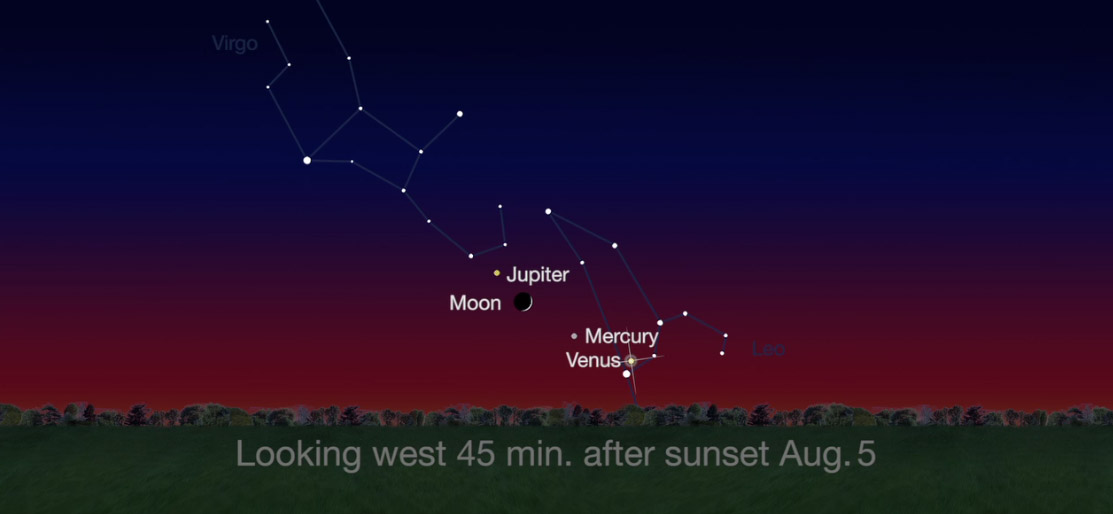
Jupiter teams up with the crescent moon in the evening twilight on Aug. 5, and the encounter will make for an eye-catching show. It's likely your last chance to see Jupiter and the moon in the evening sky this year, so you won't want to miss this!
Jupiter will soon end its brilliant yearlong showing in the evening sky; August will be the last full month that we'll be able to see the giant planet. On Friday evening, the planet will rendezvous with a slender crescent moon — a moon so thin that, initially, it may be rather hard to detect in the sun's afterglow.
From the eastern U.S., the moon will appear to hover about 2 degrees below Jupiter, but the gap between them will get noticeably smaller as they both descend in the western sky. From the western U.S., the celestial bodies will appear even closer together — only about a degree apart. The waxing moon will be 10 percent illuminated and only three days past new phase. The pair will set about 1.75 hours after sunset. [Visible Planets, August 2016: Where & How to See Them]
To increase your chances of seeing both the moon and Jupiter, make sure your prospective viewing site has a very clear and unobstructed view toward the west-northwest part of the sky. A half hour after sunset, the moon and Jupiter will hang about a dozen degrees above the western horizon. Remember: 10 degrees is roughly equivalent to the apparent width of your clenched fist held at arm's length — so about half an hour after sunset, the moon will appear just over a fist above the horizon. Jupiter will be a bright, white dot against the bright twilight background.
Right after sunset, first scan around the western sky with binoculars; once you spot Jupiter and the moon, it will be easier to glimpse the pair with your unaided eyes, especially as the twilight deepens.
Don't overlook Venus
There's another planet lurking in the western twilight sky, too: Venus. But that planet is even lower in the sunset than Jupiter for most of August. Seemingly to compensate for its lower altitude, Venus is nearly eight times brighter than Jupiter and is working its way slowly upward as the weeks go by. Search for it near to the west-northwest horizon about 20 minutes after sunset. Venus and Jupiter move 1 degree closer together each evening until reaching a very close conjunction on Aug. 27, when they'll be less than 0.1 degree apart as seen from the eastern half of North America. This event will be worth a special trip with binoculars to someplace commanding a scenic view of the western horizon.
Farewell until the fall
After this month, you can pretty much say goodbye to Jupiter as an evening object, as it will be rapidly swallowed up by the sunset glow. There actually will be one more evening rendezvous between Jupiter and the moon on Sept. 2, but that will be a very challenging observation. Odds are that the very low altitude and bright sky backdrop will preclude you from seeing the moon and Jupiter, but if you do get even a fleeting glimpse of them, you will have really accomplished something.
Get the Space.com Newsletter
Breaking space news, the latest updates on rocket launches, skywatching events and more!
Jupiter will be in conjunction with the sun on Sept. 26 and will not reappear again until sometime in early October, when it will transition to the early morning sky.
Joe Rao serves as an instructor and guest lecturer at New York's Hayden Planetarium. He writes about astronomy for Natural History magazine, the Farmer's Almanac and other publications, and he is also an on-camera meteorologist for News 12 Westchester, New York. Follow Space.com @Spacedotcom. We're also on Facebook and Google+. Original article on Space.com.
Join our Space Forums to keep talking space on the latest missions, night sky and more! And if you have a news tip, correction or comment, let us know at: community@space.com.

Joe Rao is Space.com's skywatching columnist, as well as a veteran meteorologist and eclipse chaser who also serves as an instructor and guest lecturer at New York's Hayden Planetarium. He writes about astronomy for Natural History magazine, Sky & Telescope and other publications. Joe is an 8-time Emmy-nominated meteorologist who served the Putnam Valley region of New York for over 21 years. You can find him on Twitter and YouTube tracking lunar and solar eclipses, meteor showers and more. To find out Joe's latest project, visit him on Twitter.









